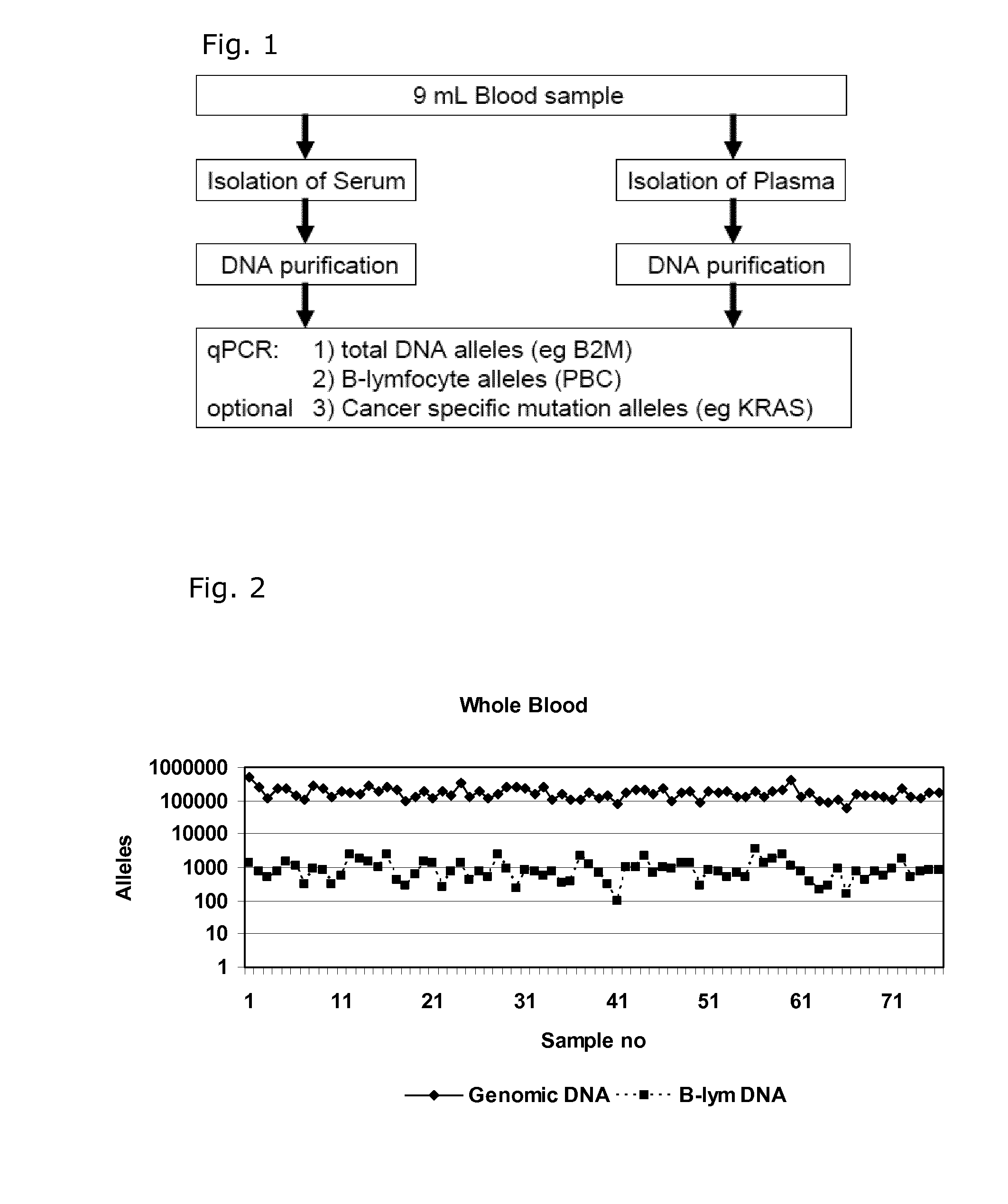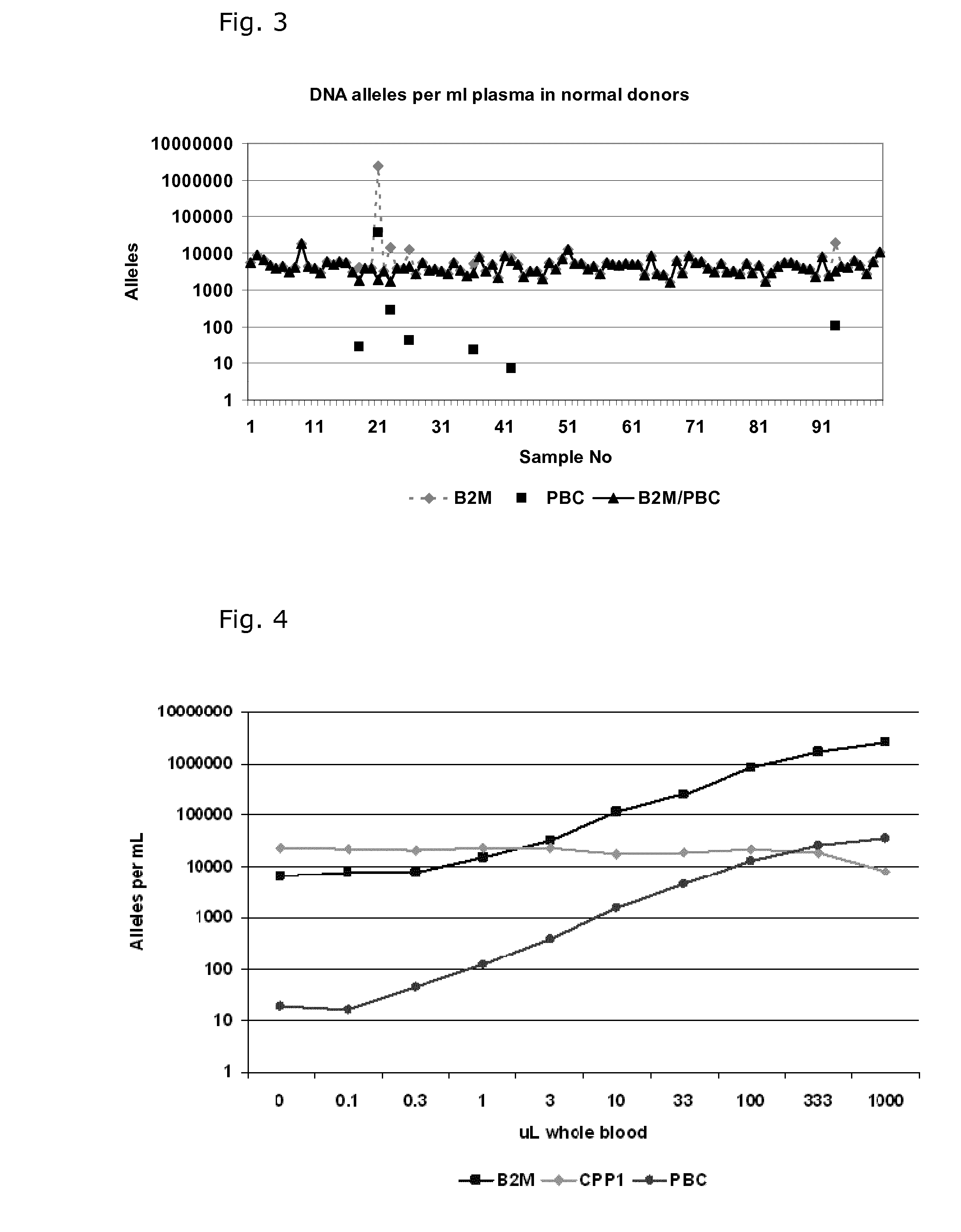Method for Analyzing Body Fluid Samples
a body fluid and sample technology, applied in the field of body fluid sample analysis, can solve the problems of increasing the risk, falsely increasing the level of cfdna, and contaminating the plasma and serum samples with cellular dna
- Summary
- Abstract
- Description
- Claims
- Application Information
AI Technical Summary
Benefits of technology
Problems solved by technology
Method used
Image
Examples
example 1
[0081]Quantification of Cell Free DNA and Detection of B Cell DNA in Plasma
[0082]Plasma was obtained from 9 ml EDTA-blood samples by centrifugation at 2000 g for 10 min within 2 hour and stored at −80° C. until use. DNA was purified from 1.2 ml plasma samples using a QIAsymphony virus / bacteria midi-kit on a QIAsymphony robot (Qiagen) according to the manufacturer's instructions. DNA was eluted in volume of 110 μL in the supplied buffer.
[0083]DNA was purified from 200 μL whole blood using a Maxwell 16 Blood DNA purification kit on a Maxwell 16 purification robot (Promega) according to the manufacturer's instructions. The DNA was eluted in 300 μL.
[0084]The number of genomic DNA alleles was qualified by real time quantitative PCR (qPCR) using a primer set for the beta-2-microglobulin gene (B2M) with an amplicon size of 102 base pairs:
Forward primer:(SEQ ID NO: 1)TAAAACTTAATGTCTTCCTTTTTTTTCTC Probe:(SEQ ID NO: 2)Fam-CCTCCATGATGCTGCTTACATGTCTC-Tamra Reverse primer:(SEQ ID NO: 3)AAACATTTT...
example 2
[0094]Selection of Additional Primers and Probes for Identification of B Cell IgH Rearrangements
[0095]Sequences of the JH-genes including a 3′ downstream non-coding region were aligned using the CLC Genomic workbench software (CLC Bio, Aarhus, Denmark). From the alignment a consensus TaqMan probe (Fam-ACCCTGGTCACCGTCTCCTCAGGTG-Tamra (SEQ ID NO:7) was designed detecting the coding region of the IGHJ1, IGHJ2, IGHJ4 and IGHJ5 genes.
[0096]Reverse primers adjacent to the probe located downstream in the non-coding region were designed for the 4 IGHJ-genes:
RJH1(SEQ ID NO: 8)CGCTATCCCCAGACAGCAGA RJH2(SEQ ID NO: 9)GGTGCCTGGACAGAGAAGACT RJH4(SEQ ID NO: 10)CAGAGTTAAAGCAGGAGAGAGGTTGT RJH5(SEQ ID NO: 11)AGAGAGGGGGTGGTGAGGACT
[0097]From alignments, forward primers from the consensus of the IGHV1-7 gene families were designed:
VH1(SEQ ID NO: 12)GAGCTGAGCAGCCTGAGATCTGA VH2(SEQ ID NO: 13)CAATGACCAACATGGACCCTGTGGA VH3(SEQ ID NO: 14)TCTGCAAATGAACAGCCTGAGAGCC VH4(SEQ ID NO: 15)GCTCTGTGACCGCCGCGGA VH5(SE...
example 3
[0102]Selection of additional primers and probes for identification of B cell IGK and IGL rearrangements
[0103]Primers for Amplifying IGK Rearrangements:
[0104]Sequences of the IGKV1- and IGKV2-genes were aligned using the CLC Genomic workbench software (CLC Bio, Aarhus, Denmark). From the alignment, two consensus TaqMan probes
IGKV1p(SEQ ID NO: 19)Fam-CAGCCTGCAGCCTGAAGATTTTGCA-Tamra IGKV2p(SEQ ID NO: 20)Fam-ATGCTGAGGATGTTGGGGTTTATTG-Tamra
were designed detecting the coding region of the IGKV1 and IGKV2. Reverse primer adjacent to the probe located downstream in the coding region was designed for the IGKJ1 to 4 genes:
IGKJ14(SEQ ID NO: 21)TTTGATCTCCACCTTGGTCC
[0105]From alignments, forward primers from the consensus of the IGKV1 and IGKV2 gene families were designed:
IGKV1(SEQ ID NO: 22)GGACAGATTTCACTCTCACCAT IGKV2(SEQ ID NO: 23)CATGCTGAAATCAGGAGGAT
[0106]To test the functionality combined with the gene usage, multiplex primer sets are assembled and tested on normal donor DNA from whole ...
PUM
| Property | Measurement | Unit |
|---|---|---|
| melting point | aaaaa | aaaaa |
| volume | aaaaa | aaaaa |
| volume | aaaaa | aaaaa |
Abstract
Description
Claims
Application Information
 Login to View More
Login to View More - R&D
- Intellectual Property
- Life Sciences
- Materials
- Tech Scout
- Unparalleled Data Quality
- Higher Quality Content
- 60% Fewer Hallucinations
Browse by: Latest US Patents, China's latest patents, Technical Efficacy Thesaurus, Application Domain, Technology Topic, Popular Technical Reports.
© 2025 PatSnap. All rights reserved.Legal|Privacy policy|Modern Slavery Act Transparency Statement|Sitemap|About US| Contact US: help@patsnap.com


